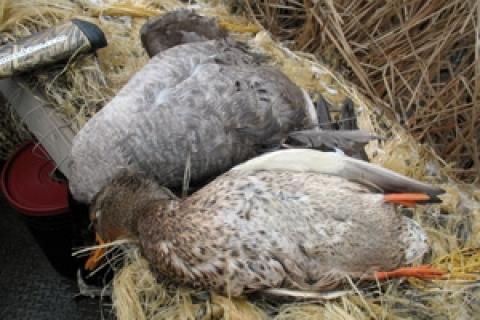
Most people who tie flies spend an awful lot of time visiting their local fly shops or pouring over catalogues in search of material. For the most part, I'm no different.
But come autumn, I also try to collect a little from nature's bounty. After all, so long as you have a hunting license it's there for the taking.
 Duck, pheasant, grouse and woodcock feathers, along with buck and squirrel tails, and moose, deer, hare and bear fur are all available to the fly tyer who hunts.
Duck, pheasant, grouse and woodcock feathers, along with buck and squirrel tails, and moose, deer, hare and bear fur are all available to the fly tyer who hunts.
Collecting fly tying materials on the hoof, so to speak, provides additional satisfaction in that you are making even better use of the animal you have harvested. Moreover, when tying flies with the fur or feathers you've personally collected, there is this feeling that the fly is even more local and organic. I'm not sure why, but that sentiment sits well with me.
Needless to say, not everyone hunts everything. For instance, I happen to hunt a lot of ducks, deer, squirrels, grouse and woodcock, so I am generally well stocked in the fur and feathers they provide. But that's not always the case when it comes to other types of material such as bear or moose. So I put out a call to friends who target those species and ask them to consider collecting material for me.
Most are happy to oblige. In return, those who tie flies might get a package of wood duck feathers from me or other fur or feathers from animals they might not normally hunt. Those who fly fish often receive a dozen or so flies tied with the material they provided. It's a small gesture but it shows appreciation and ensures that they remember you in seasons to come.
If you are collecting your own feathers or fur, there are a few things that you should remember.
First, don't collect anything that is bloody.
When it comes to feathers, I tend to pluck prime ones from the bird and let them dry out if wet. Then, I place them in a Ziploc baggie or container and write on the outside what is contained within. I always keep a few baggies handy at my car, in fact, just for this.
I'll remove fur by skinning, making sure minimal flesh and meat is attached. Then I will salt or borax the flesh to dry it out and preserve it. After that the same storage process applies.
Do this right and the material you collect will last for years.
Some tyers will skin out a while bird or animal and keep the entire skin. This is time consuming but definitely worthwhile if you do it. Again, make sure you borax or salt the flesh side.
There are plenty of great reference materials on-line and in books that will show you the location of feathers and fur that are most useful on the animal too. Be familiar with these and prepared and you'll never have to worry about quality fly tying materials again.
- 4257 views

